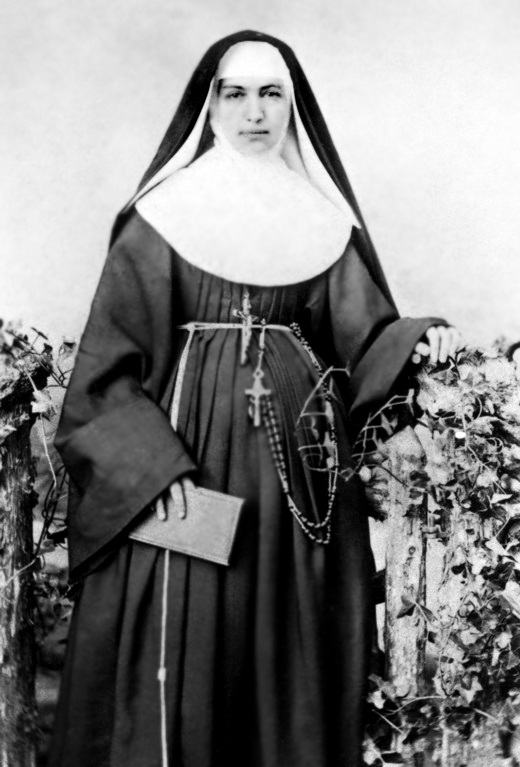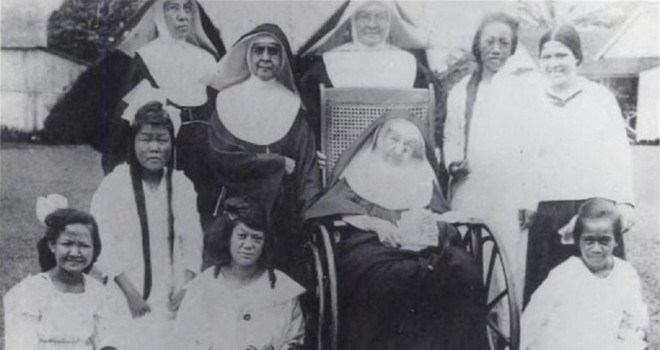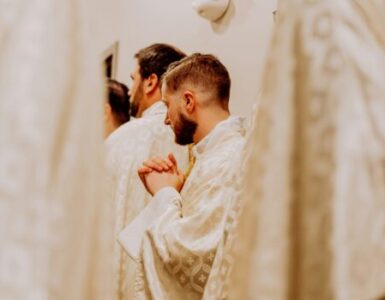Lo, beauty springing from the breast of pain!
He marks the sisters on the mournful shores;
And even a fool is silent and adores.
Thus wrote the Presbyterian literati Robert Lewis Stevenson after seeing the incredible work of St. Marianne Cope, whom we celebrate today. When Stevenson had visited the island of Molokai, Hawaii he was there to observe the work of the recently-passed St. Damien of Molokai among the lepers, possibly the most outcast people on the planet.
Leprosy, or Hansen’s disease, is a pretty frightening disease by 21st century standards. In the 19th century, a leprosy diagnosis was effectively a death sentence. Historically, it was also considered highly contagious and so lepers were expected to keep their distance. Yet, Mother Marianne dedicated her life to serving the forgotten and neglected.
For this and many other reasons, Mother Marianne Cope is the patron saint of lepers. She is also the patron saint of outcasts whose lifetime of love and work provided a mother to the motherless.
In a time of scandal, confusion, and disappointment, Mother Marianne shows us how sacrificial love can radically change the world. She also shows us that, with God’s help, beauty can spring fourth from even the most brutal of pains.
Born to Serve
Marianne was born in 1838 to a poor immigrant family and she supported them with her own work and service. Her parents had immigrated to the Utica, New York from Germany and each family member had to work, usually in a factory.
While Marianne felt called to religious life from a young age, her father’s declining health delayed those plans. As an eighth grade student, Marianne found herself with the task of caring for her family until her siblings matured. As well as working at a textile factory, she took care of her ailing father.
The family is the domestic church and here we see young Marianne’s heart to serve that church. No doubt, her vocation was not going as she dreamed it would. But, as a provider and comforter, her path of love and holiness was already being shown in the love she showed for her family.
After nine years of service to her family, Marianne began her life with the Sisters of the Third Order Regular of Saint Francis in Syracuse, New York in 1862.
Hospital Pioneer
 After formation, Marianne taught the immigrant children coming to Central New York in great waves. Soon, as a member of her congregation’s leadership, her compassion and administrative skills were used to open two of the first public hospitals in the nation. Unlike many other hospitals at this time, Mother Marianne made sure that the charters provided care for patients, no matter their ethnicity or class status.
After formation, Marianne taught the immigrant children coming to Central New York in great waves. Soon, as a member of her congregation’s leadership, her compassion and administrative skills were used to open two of the first public hospitals in the nation. Unlike many other hospitals at this time, Mother Marianne made sure that the charters provided care for patients, no matter their ethnicity or class status.
For all this, her work with “outcasts” of that time caused some controversy, especially her loving care of alcoholics and other addicts. While some raised eyebrows at the idea of admitting such social outcasts, the people of New York grew to love and respect the heroic and hard-working nun.
Her work as a hospital administrator would be enough to secure Mother Marianne Cope in the history books as a great American innovator. God had other plans because there were outcasts in the Pacific who hungered for a love they had not yet received.
Mother to Lepers
At this time, officials with Kingdom of Hawaii sought out religious orders to care for the many people suffering from leprosy. Fifty religious superiors had already declined before Mother Marianne Cope accepted their plea for help. With enthusiasm and love, she responded to the call, stating,
I am hungry for the work and I wish with all my heart to be one of the chosen Ones, whose privilege it will be, to sacrifice themselves for the salvation of the souls of the poor Islanders… I am not afraid of any disease, hence it would be my greatest delight even to minister to the abandoned ‘lepers.’
Fear was what caused the lepers to be forcibly isolated from their communities. It is fear that keeps many of us acting in a loving manner. Mother Marianne didn’t even fear what was thought to be a highly contagious disease. For her, sacrifice and love were the only things that mattered and so she and her sisters made the grueling journey to Hawaii.
It’s easy to forget how much courage it takes to love anyone. Even the safest of loves opens you up to heartache and disappointment. However, Mother Marianne had a heart to care for the forgotten thousands of miles away. When they most needed her, Mother Marianne provided a motherly love to countless women and girls who were suffering from leprosy.
Mother Marianne used her administrative skills to raise funds to build facilities for the leper colony while seeing that every patient got compassionate care. She cleaned the wounds herself and even provided patients with small comforts like new dresses or books. While the world had abandoned the lepers on Molokai, the saint from Syracuse saw to it that they were loved as children of God while acknowledging their humanity.
“Martyr-Like Devotion”
Mother Marianne Cope only planned to be in Hawaii for a few years. Much like with her father, she found that her greatest calling was to care for the people who most needed her at that very moment. And so she remained on Molokai until her death at the age of 80.
She had lived a long, courageous life of service, risking even her own life. But her radical love was needed and thus she remained on Molokai for over two decades, working until her last day. Her service was noted by those outside the leper colony and her death was mourned by thousands, Catholic and non-Catholic.
Unlike her friend Fr. Damien, Mother Marianne never came down leprosy but instead worked long after her own health began declining in old age. Even after being confined to a wheelchair, Mother Marianne provided a mother’s love to the motherless with her work. By the end, she was suffering from edema and could barely move or sleep.
Newspapers at the time mentioned her martyr-like devotion to society’s forgotten. On laywoman summed it up quite perfectly: “She was a heroine in her life; she is a martyr in death.” This sentiment was widely shared in Hawaii and beyond.
Even death couldn’t stop Mother Marianne Cope. Many tell stories of miracles obtained after asking for her intercession. Mother Marianne lives her heavenly life as she did her earthly one: in love and service to anybody who needs her.
St. Marianne Cope, Ora Pro Nobis
If you haven’t noticed, our world could use a radical, courageous love like that of St. Marianne Cope. Sure, you’re probably not going to be able to head to an isolated island to care for the forgotten. But you don’t have to go far to find the outcasts and forgotten souls in need of love. In fact, they’re probably in your parish, in your neighborhood, or even in your home.
Loving the forgotten is difficult and sometimes dangerous. It won’t make you a lot of money and it can be exhausting. Like St. Marianne, we’re going to have to trust in God completely and love with the same passion by which He loves us. This is what God calls to each of us. Like St. Marianne or Isaiah, we have to be ready to say, “Here I am. Send me!”
On her feast day, and every day, call out to St. Marianne Cope to teach your heart how to love the forgotten. Then have her courage when its time to dress wounds, be they spiritual or physical. Such a courageous love can heal hearts and give a light that shines even after we’re gone.
St. Marianne Cope, pray for us!













